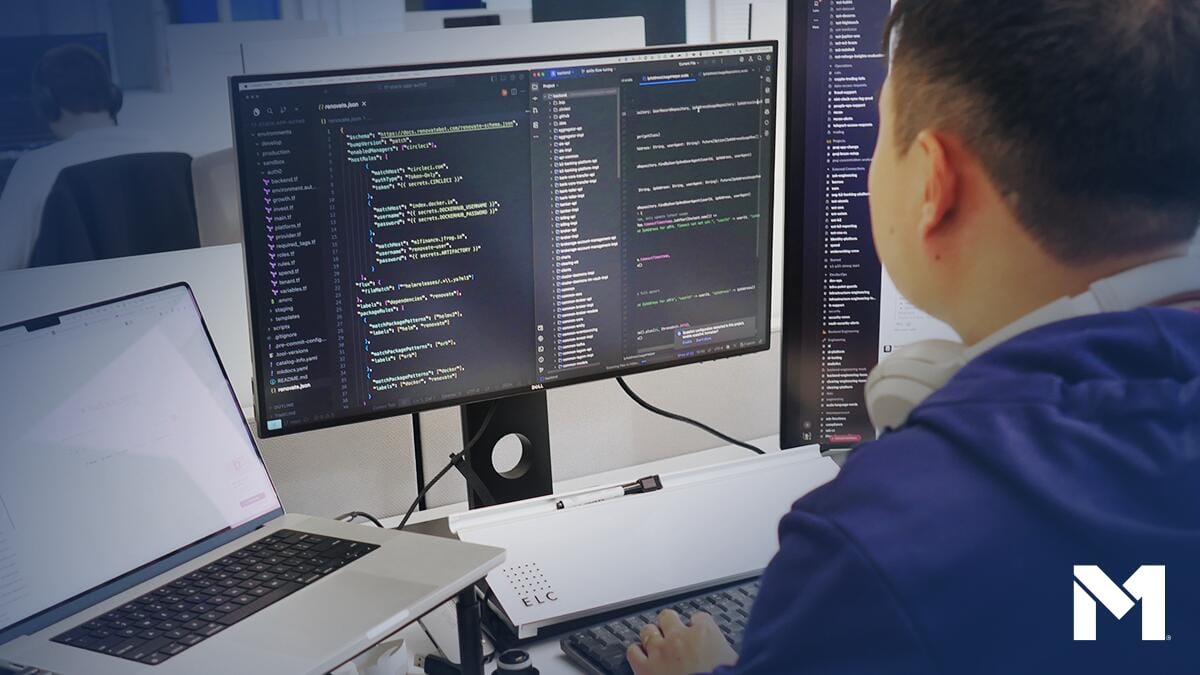AI at M1: How the M1 Team Uses Artificial Intelligence Every Day

At M1, AI is a major part of how we plan, build, and safeguard the platform every day. From design and engineering to operations and compliance, teams across M1 have been using AI to move faster and operate at scale. Here’s how four teammates put AI to work.
Product design: research partner, concept catalyst, and a bridge to better collaboration
Jessica S., M1’s Head of Product design, uses AI across the design lifecycle—from research and concepting to documentation and collaboration.
Research and synthesis: When it comes to product development at M1, our team relies on a lot of client research. To do that, we set up interviews through an AI-enabled service called Great Question. This allows us to protect the privacy of interviewees and review summaries of the interviews.
After conducting interviews, Jessica’s team uses Great Question’s AI features to summarize conversations and pull out common themes. “It’s not perfect—but it was a big game-changer.” The AI features turned what used to be days of research into minutes or hours.” For market and strategy work, she taps ChatGPT as a research partner to pressure test ideas and ask the “what are we missing?” questions.
Concept exploration: Another tool in the design team’s toolbox is Figma Make, which designers have used of late generate lo‑fi concepts and options to spark direction early. This is no substitute for human creativity and development, but it can help accelerate the design process in early stages. In Miro, they brainstorm with AI-assisted sticky note clustering to quickly sort ideas by themes and sentiment. This makes collaboration much quicker and helps the design team get on the same page.
Documentation and design systems: Jessica also looks to LLMs like Claude or GPT to help draft and refine component documentation—specs, behaviors, and guidelines—for engineers. This is a complicated process filled with jargon. The models’ baseline knowledge of design systems helps with clarity and brevity, allowing the team to start with a baseline and tighten the details from there.
Future vision—from design to code: As part of M1’s Liquid design system initiative, Jessica and team are exploring how AI could help translate design intent into code more reliably. Design-to-code workflows represent an exciting frontier for speeding up iteration, strengthening alignment with engineering and speeding up delivery.
Team ops and content: As a team manager, Jessica has a lot of operational duties to take care of. To tackle these, she uses Zoom’s AI companion to handle meeting notes and transcripts. This helps reduce the burden of manual documentation, letting teams stay present to discussions rather than taking notes. For in-product copy, LLMs generate quick drafts and alternative options designers then refine to get a final version.
AI at M1: Looking ahead
While the team isn’t yet using AI to write production code, Jessica sees a clear path where AI at M1 will help close gaps between design intent and engineering execution.
“There’s still more potential out there,” she says. “I have a vision for where product design is moving—using AI to prototype and even code. We haven’t historically been a team that codes our designs; these tools can help us bridge the gap while still moving quickly.”
This vision aligns with M1’s broader Liquid design system initiative—building a foundation that will eventually enable more automated, intelligent, design-to-code workflows.
Engineering: an extra pair of hands
As a FinTech company, M1 relies on our engineers to build, test and ship our product. Senior Engineering Manager Alex A. calls GitHub Copilot, Cursor, and Claude Code the “big three” in his day-to-day. They help with first drafts of design, implementation, and debugging.
Faster starts, fewer stalls: For new projects and repetitive tasks, Alex notes that AI can scaffold projects, configurations, and tests, enabling teams to move faster. During debugging, it helps parse logs and error reports at a scale, coupled with human intuition and experience, it helps us balance rigorous Fintech standards and speed.
Data and analysis: From writing SQL queries to analyzing service telemetry, AI reduces the cost of exploring options so engineers can validate assumptions sooner.
No tool is perfect. “Claude Code is often the best for us, but every tool has trade-offs,” Alex notes. “The biggest wins come from tools that plug into our native workflows.”
Operations: turning heavyweight rules into working systems
Director of Operations Ryan F. uses AI to translate dense financial regulations into action—and increasingly, into code.
Digesting complexity: With ChatGPT, Ryan says he can get a “clear TL;DR” of the long, technical FINRA/SEC/IRS guidance that comes with being in the financial industry. He turns to LLMs to explore how specific rules might apply to a scenario he’s working through. That speeds up understanding before he dives in for a deeper review.
From spec to prototype: When M1 began owning more of our margin maintenance requirements, Ryan wrote the business spec and—using Cursor—prompted robust Python to ingest market data (like market cap, volatility, price, sector) and compute maintenance requirements. The system compares three sources: the regulatory minimum, our clearing partner’s rules, and our internal model. It defaults to the most conservative outcome.
Real impact: What once would take two weeks of engineering time can become a two-day proof of concept the team can validate and harden. “It made me confident we can use AI for these projects,” Ryan says. “It’s a way to tackle lower-priority ops needs without pulling a full sprint from engineering.”
Compliance: faster reviews, fewer false positives, stronger guardrails
And of course, operating in a regulated industry requires a lot of oversight. That’s why M1 has a robust compliance team to review language, legal terms, and marketing materials before they ship. Senior Compliance Director Tealee H. leverages AI to draft, review, and monitor at scale— with a final touch of human verification.
Policy research and drafting: Tealee uses LLMs like Claude and ChatGPT to identify relevant regulations and draft policy language she then verifies and tailors. It’s a faster starting point that keeps the team focused on interpretation and nuance.
Marketing and communications review: To review marketing materials, client communications and in-product language, Tealee’s compliance team relies on a vendor who leverages AI. AI can flag content and give feedback about potentially problematic language.
Supervision at scale: The compliance team also utilizes AI to review electronic communications and complaints, analyzing content for regulatory concerns and potential PII exposure. Unlike legacy systems that trigger on single keywords, it uses context to reduce false positives and even detects sentiment to surface potential customer service issues sooner.
Tealee’s mantra is simple: AI speeds the work, humans own the judgment. She’s also collaborating on our broader perspective on AI ethics and responsible use.
How we make AI at M1 work for us
A few themes show up across every team:
We keep humans in the loop. AI at M1 is used to draft; people decide. We verify sources, test outputs, and keep accountability with the humans who ship the work.
We put privacy and security first. We apply data minimization, redaction, and vendor controls as part of our standard workflows. All of our LLM usage is on an enterprise-level, so the inputs are protected.
We move fast, without breaking things. With AI tools at our disposal, days collapse into hours. Boilerplate takes minutes. Design system components get a big head start. Sprints go 10x faster. And it’s done without lowering the bar for quality.
We continue to learn. Every tool has trade-offs. We evaluate, instrument, and iterate—choosing the right fit for each job.
We’re excited about what’s already possible and even more excited about what’s next for AI at M1. As Jessica put it, “These tools will evolve.” And we’re building the muscle to evolve right along with them, making our team more nimble, effective and successful.
SAIF-11182025-4pfihzfj
- Categories
- M1
- Tags



